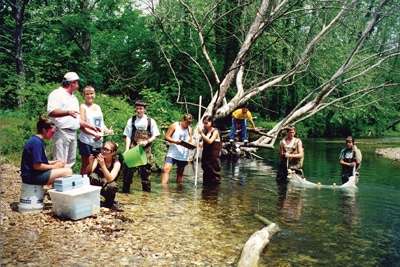Blue Thumb Exceeds 100 Stream Monitoring Sites
Local Teams Make Up Statewide Effort

Oklahoma’s Blue Thumb water pollution education program is marking a centennial! No, Blue Thumb is not 100 years old, but Blue Thumb teams are now monitoring over 100 stream sites statewide.
The Blue Thumb Program started in Tulsa County in 1992, expanded to Oklahoma County one year later and began spreading throughout the state in 1997. Blue Thumb is sponsored by the Oklahoma Conservation Commission, Oklahoma’s conservation districts, and the U.S. Environmental Protection Agency Region 6. OCC’s Water Quality division administers the program.
The Blue Thumb teams are active in 29 of Oklahoma’s 77 counties. Those counties are the following with the number of active monitoring sites in parentheses: Blaine (3), Caddo (1), Canadian (2), Cherokee (8), Cleveland (2), Comanche (6), Creek (6), Custer (2), Delaware (2), Ellis (1), Harper (1), Haskell (1), Johnston (2), Latimer (4), LeFlore (5), Logan (4), Mayes (1), McClain (1), McCurtain (4), Murray (2), Oklahoma (10), Okmulgee (2), Osage (4), Ottawa (3), Payne (7), Pontotoc (3), Roger Mills (1), Rogers (2), Tulsa (13).
“What’s really special about our 100 active sites is the citizen effort required to accomplish this level of monitoring,” said Cheryl Cheadle, Blue Thumb program coordinator.
More than 400 active volunteers contributed more than 8,000 hours to stream protection through Blue Thumb last fiscal year. Volunteer teams consist of middle school, high school, and college students and instructors, professionals, retired people, farmers, ranchers, and others with an interest in clean water. Blue Thumb volunteers monitor streams, screen groundwater, and perform many educational activities that help citizens understand that everyone can take steps to keep water clean.
“I am thrilled that there are this many people in the state who have made such a commitment,” Cheadle said.
New volunteers are required to go through a free, two day training regarding watersheds, pollutants, and monitoring team skills, including use of water quality test kits, field activities, and working with people. After training, volunteer teams collect water chemistry and site information on a particular stream each month. Teams work with Blue Thumb staff to collect benthic macroinvertebrates (primarily small aquatic insects, crustaceans, and mollusks) twice each year and fish every four to five years. Volunteers assess in-stream habitat concurrently with fish collections. It takes these three pieces of information – water chemistry, stream life, and in-stream habitat – to really know something about a stream, Cheadle said.
Data collection is just the beginning, however. Blue Thumb staff members work with volunteers to compile their data for meaningful analysis. The principal question asked by both monitoring volunteers and Blue Thumb staff is “How is this creek?”
Once a complete data set is compiled, volunteers work with Blue Thumb staff to review, analyze, and interpret the data. As Blue Thumb educator Kim Shaw explains, “Jean Lemmon (Blue Thumb Quality Assurance officer) and I work extremely hard pulling together every shred of data on a stream to form a packet for each site. We then meet with the volunteers from these streams to discuss and explain the data packet.” Thirty data reports have been completed for streams monitored by Blue Thumb volunteers, and more reports are forthcoming. Kim adds, “Jean and I proofread every document, and I am highly impressed with the reports our volunteers complete.”
Neither staff members nor volunteers were aware that the Blue Thumb program was near the 100 monitoring team level. Quality assurance officer Jean Lemmon was working with the sites list for the upcoming quality assurance sessions when she realized that 103 of the 248 total Blue Thumb sites were being actively monitored. “We have sites all over the state that have been monitored by volunteers through the years. I realized that we now have more than 100 sites active at the same time!”
“Volunteers come aboard because they want to do something positive for the environment. There are lots of people who are concerned for our streams and rivers, but Blue Thumb volunteers get up, get outside, and get something done,” Cheadle said.
